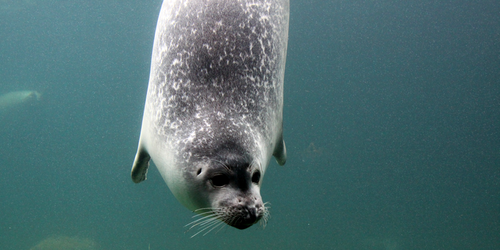Sensing Fish at a Distance
In turbid coastal waters where visibility is poor, harbor seals track their prey using their whiskers. These long, stiff hairs are sensitive to the turbulent forces produced by nearby fish. Most efforts to understand this sensing have focused on situations in which the hunter is directly downstream of its prey, following at a fixed distance. Now Pengyao Gong and colleagues at the University of Texas at Dallas have experimentally studied the phenomenon for varying distances and orientations between the two animals [1].
When a fish moves through water, it sheds vortices from its skin, which produce a turbulent wake behind the fish. These vortices are known to induce so-called wake-induced vibration (WIV) in the whiskers of a pursuing seal.
Gong and colleagues studied this phenomenon experimentally. They replaced the fish with a vertical cylinder, which they drove through the water horizontally, and the whisker with a much thinner rod that was fixed at one end. In most cases, the team found that the strength of the WIV fell as the cylinder–whisker distance increased. But when they moved the cylinder away very rapidly—an experiment meant to replicate a sudden burst in a fish’s speed—this WIV falloff slowed because of the stronger wake vortices generated by the cylinder’s faster motion.
The team also found that the whisker oscillations were sensitive to the relative positions of the whisker and the wake: when the two were misaligned, the wake still induced whisker vibrations, but the vibrations’ equilibrium position was different. The researchers say that their results show that the motion of a seal’s whiskers could provide the animal with a wealth of information about its prey’s speed and direction.
–Marric Stephens
Marric Stephens is a Corresponding Editor for Physics Magazine based in Bristol, UK.
References
- P. Gong et al., “Coupling between vortex flow and whisker sensor in cylinder wakes with time-varying streamwise gaps,” Phys. Rev. Fluids 8, 034701 (2023).




